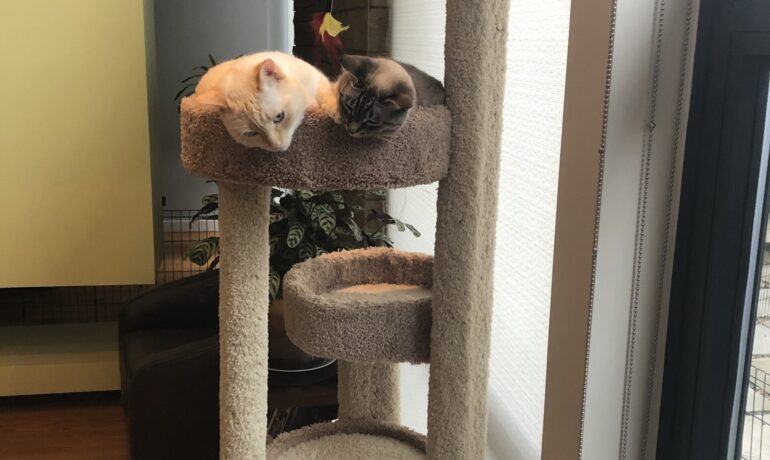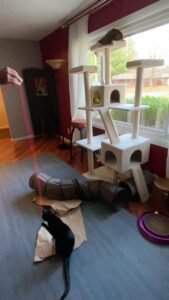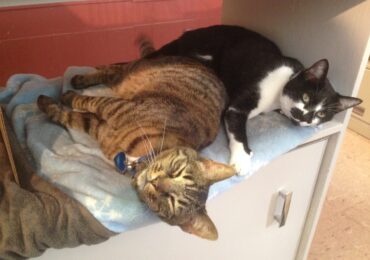Introduce cats to each other
When you add an additional cat to your home, your existing cat may not accept this cat easily. Many cats need a formal introduction plan to learn to accept each other. Preparing the home for the introduction, and addition of the new cat needs to happen before the big meet up. It may seem odd, that a housecat may not want a companion when seeing many multi-cat homes. Cats can learn to live together, yet the home must accommodate the needs of all the cats to avoid fights, litter box problems, or anxiety problems. This is especially important if a partner or family member is moving in with their beloved cat. A lot of human tension arises when the pet of one is not getting along with the other. This tension can spread to the cats, worsening behavior problems.
Understand feline behavior

Cats retain many of the traits from their less domesticated days, even as a house cat. There is a need to hunt, rest on individual perches, and have individual toilet areas. These needs relate to the solitary nature of the wild cat. Felines hunt alone, they do not depend on buddy cats to help round up prey, pounce, and kill. Cats are successful about 50% of the time they attempt to kill their small prey, and any other cat who may pounce on the prey is seen as a competitor for the meal. In short, a cat does not like to share the source of food – they want multiple areas for feeding, especially small sources they need to search for. When there is one food bowl for multiple cats or bowls nearby each other, the cats see each other as competing for food. This increases tension between the cats.
Feline play behavior is based on predatory behavior. Kittens begin to use predatory play as a way to sharpen their hunting skills at 12 weeks of age and continue to use predatory play as an outlet for energy and release boredom AAHA behavior development by life stages in cats. When owners use one toy to entice play, this creates a sense of competition between the cats. Also, cats under the age of 3 may continue to provoke predatory play with an older housemate cat. The older cat is often no longer motivated to play in this way and now perceives the pouncing – grabbing play as aggression. Hissing, growling, and chasing is feline aggression and may increase housemate tension through out the day. Younger cats need an outlet for predatory play directed away from the housemate cat.
Urination and defecation is a normal marking behavior. When we offer a cat a litter box, we are asking them to limit their marking to this confined space. If the cat senses their own scents, they will use this box provided it is not over marked. Sharing a litter box creates a sense of competition between the cats. This is why it is recommended to have a litter box for each cat plus one preventative vet litter box recommendations.
Perches and resting places are important for each cat to sense they have their own, at the level they prefer. It is also important that cats have the seclusion or open view that they like in these perching areas. Often when we add a new cat we do not realize that these perches need to be in place immediately. Without these additional perches, you will see more chasing, staring or hiding, and anxiety in the cats. My rule of thumb is a minimum of 3 perches per cat in the home in various areas and various levels.
Lastly, cats need to scent the home and each other to feel they all belong to the same environment. Rubbing the head along furniture, your hands, and co grooming is the primary way cats share scent. When cats have not met, they feel like they are foreign to each other. Using the marking pheromone products in the home helps the cats to feel like they know each other, and improve introductions.
Introduction – Step 1
In the first step, our goal is for each cat to feel tolerant knowing the other is nearby but out of sight. Eating requires anxiety to be low. If the cats will not eat – they are too tense and this will lead to aggression if you push the introduction too fast.
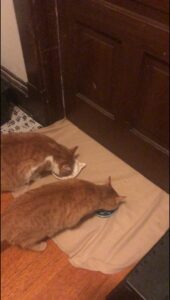
The setup; furnish a bedroom with cat food, litter box, and perching areas. The new cat will stay in this room for the first few days, then you will exchange the cats between this room and the rest of the home so each cat can scent share around the home and from the objects in the bedroom.
Spray the corners of the bed, the doorway, and perches with the pheromone spray for this cat to feel as if they have already marked the home. Spray the pheromone spray around the outside of the door and doorway as well.
Put a fleece blanket under the door, to extend on each side. You will feed the cats with one cat on each side daily, starting at the outer edge. This is the first step of the cats learning to tolerate each other and putting their scent on the blanket. Rotate the blanket each day to help each cat pick up the scent of the other. When the cats are eating at the door, without any hissing or staring, start step 2. Download the Feline ladder of aggression at my resources page to monitor the cat’s body language accurately for progressing through the introduction plan.
Rubbing or brushing each cat then transferring that towel or brush onto the other cat is a way to also scent share.
Learn to like each other at a distance – step 2
Once your cats are eating well at the closed door, it is time to switch to a lattice-type baby gate, with each cat maintaining at least 3 feet from each other as they play and eat. We do not want to train the cats to sit across or through the gate facing each other, on the same floor level. This activates the competition and tension. Instead, we want to teach the cats to stay at least 3 feet away from each other on the floor or have one cat up on a perch or table as they see the other cat on the floor. This is another way to maintain the 3-foot distance from each other to avoid space competition. Short 5 minute periods of feeding, and then another one where one cat plays as the other eats or plays is how they will learn to tolerate the movement of each other and sharing space. When both cats can play or eat and ignore each other at 3 feet with the lattice gate present, they can move to free time in the prepared home.
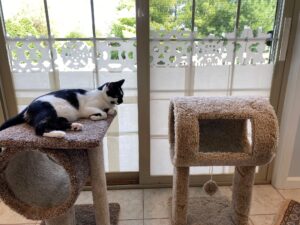
Preparing the home for – in this second step, prepare the home by adding at least 3 perches per cat in various places. When the cats have their solo time in the free space of the home, eliminate the food bowl. Instead, place 1 tablespoon of dry food, on these new perches to have your cat hunt for their food. You only need to set out 3-4 tablespoon piles twice daily. The majority of dry cat food has enough calories in this amount of food for a healthy cat to maintain a normal weight, so don’t worry – your kitty will be hungry enough to hunt for the food, and will be satisfied.
The second preparation step is to toss the food nuggets to your cat to scamper after them, pouncing and then eating them. I call this the kill your food game. It works best on a hard surface flooring to get the noise of the food bouncing. If you have carpet, a piece of sheet vinyl or hard wall covering on the floor to create a pounce place will work. This trains your cat to follow the food and leave an area. After your cat has got the gist of the game, toss the food onto the perches in play to quickly direct your cat to go up there. This is how you will help the cats to go away from each other peacefully in the living area and other areas where they competed for space. Follow the steps of this video kill your food to stop aggression video to see how I used this with my two office cats to prevent fights.
If one of the cats is very active, rushing up onto the other cat face to face, harness training this cat with a lightweight leash to control movement and allow the other cat to escape without stress is the last step you must prepare for. Start with purchasing a cat harness and have the active – forward cat wear this all day when in their confinement area and free in the home. You need this cat to like the harness and to be able to move normally as well in the harness. Follow the steps of this video how to train your cat to a harness the low stress way .
There are a number of steps to the process of having the bold cat in harness for the first meeting. I will post the specific steps for this technique in a future blog.
Controlled calm meeting – step 3
Finally! The day you have been waiting for – meeting in the living area without gates and worry.
On the big day, do not feed the cats. All of their food will be earned through the “kill your food game” or a small pile of super delicious food hunting upon the individual perches when they are released. They need to be hungry for this – hunger motivates them past their fear and aggression.
Lure the cat who needs to be up onto the higher perch. Release the other cat from the bedroom, tossing food to lure then into the living space, walking or pouncing away from the perch where the other cat is. We are teaching the cats to ignore each other. The first level of peaceful co-existence is learning to tolerate each other in the same space, This is created by learning to ignore each other – to not compete. I know you want your cats to be cuddling together, and playing nice. They are not ready for this yet – be patient as you keep working through the steps.
These meetups will last 5 minutes for the first day. If there was not any growling, staring, hissing, or following each other that is great! Separate them for 1 hour, then release them following the same steps again for 5 minutes. The cats need to have a minimum of 3 meetups without any signs of anxiety above dilated pupils before you double the meetup time. Post the feline ladder of aggression in your living space to keep track of the body language you see and keep a chart for how long they tolerated each other. If the cats show staring, hissing, or growling that persists more than 15 seconds, separate the cats and go back to the previous meet uptime.
There is hope
If you follow these steps exactly as I have outlined, your cats will come together and many have become friends over time. When people skip the steps or do not follow every step in the order I described, the cat’s needs are not met and consequently, the competition and stress continue. If you find your cats cannot calm enough to eat on the blanket your cat has a state of anxiety that requires a veterinarian to assess the best medication, supplement, or diet to reduce this anxiety. I Know your cat may be stressed to go to the veterinary clinic, or finding a veterinarian knowledgeable about feline behavior can be frustrating. Here are some suggestions: look at your veterinary clinic website or ask if they have staff certified in less stressful handling feline care, or have taken continuing education in these techniques. I can provide a behavior consult to you and collaborate with your veterinarian for the medication, diet or supplements to decrease any problems, especially after severe attacks or long-term problems.
Click here for Behavior consult info page with Dr. Foote. I can provide consults to any client, and using the video chat method I have created the custom plan for the home and cats that achieved a reunited home in a few weeks. It has amazed me how much happier the housemate cats were after the reunion in the home, by addressing all of the cat’s needs through the introduction process.
Take my course Cat behavior and health at all ages to understand your cat’s needs both physically and behaviorally to prevent problems and address them. I love to hear how this information has helped you and your cats –
Sally J Foote DVM, CABC-IAABC, LSHC-S
Better Bond- Better Behavior

